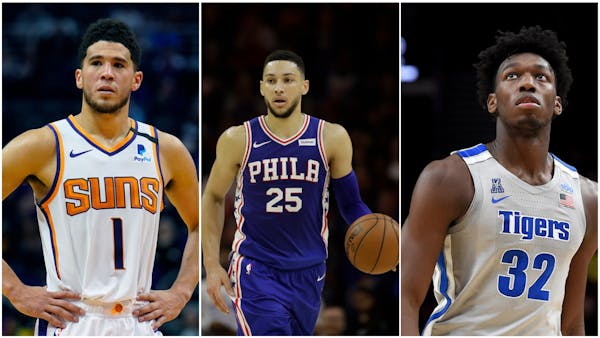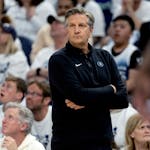This is the time of relative calm for Sachin Gupta and the rest of the Timberwolves front office.
When Gupta, the Wolves' executive vice president, and his colleagues call around the league taking the temperature of other teams as it relates to their potential interest in draft trades, the conversations can be a little more casual, more filled with small talk before getting down to business.
But as the Nov. 18 NBA draft gets even closer, soon will come the time for what Gupta referred to as the "three phone" calls, when multiple staff members will be juggling multiple phones and multiple conversations with other executives as the impending deadline of the draft looms over them.
"There's not a whole lot of pleasantries that are happening with those calls," Gupta said. "There's no time for it. It's, 'What do you want? What do you got for me?' "
With the Wolves in possession of the top pick, not to mention Nos. 17 and 33 overall, the phones have already been ringing. Even though there's no consensus No. 1 pick in this year's draft, the top pick is still a valuable asset, one that can change the trajectory of the franchise — and one the Wolves might ponder how best to utilize even after Commissioner Adam Silver puts them on the clock.
"There's always value to being the first to draft and being able to have the pick of the litter ..." Gupta said. "Often during the year you hear different evaluations of the quality of the draft, but then when it gets to draft time, all that goes out the window and it's about the reality of the decision in front of you."
Gupta worked with Timberwolves President of Basketball Operations Gersson Rosas in Houston, where Gupta worked as a special adviser before joining the Pistons. Gupta also served under former 76ers General Manager Sam Hinkie and helped craft some of the trades that netted them high draft picks.
Gupta has earned his reputation in the NBA in part because of his deft ability around the salary cap and crafting trades. Sometimes those trades can be complicated, like the four-team deal the Wolves struck in February that sent out a large chunk of their roster including Robert Covington, and brought in the 17th pick from Atlanta via the Nets along with Malik Beasley and Juancho Hernangomez from Denver.
So when Gupta — who also helped design code for the ESPN trade machine tool that lets fans concoct their own hypothetical deals — learned the Wolves had the No. 1 pick, his mind began racing.
"It's fun sort of brainstorming together as a group," Gupta said. "[Assistant general manager] Manny Rohan and I spend a lot of time together throwing ideas back and forth and trying to come up with all the possibilities that might be available to us with those picks. There are endless possibilities and we're trying to uncover all of them."
Those possibilities take some finessing to put into action, and the Wolves have been laying the groundwork for months, gathering all the intelligence they can as to how other teams may value the No. 1 pick. They certainly put a heavy price tag on it, even without a consensus superstar at the top.
"That opportunity cost of being No. 1, of being able to maximize that value, whether it's picking or trading, means an incredible amount year in and year out for any organization," Rosas said. "It's significant in the millions of what that means for an organization."
Getting down to business
That meaning can manifest either in the player the Wolves draft or what they may get in a trade for the pick. It's not often the No. 1 pick switches hands before that player suits up at least one season for a team.
There seems to be a consensus top three in the draft this year, with LaMelo Ball, Georgia's Anthony Edwards and Memphis' James Wiseman rounding out that tier.
Among those rumored to be pondering a move up is Charlotte, which has reported interest in drafting Wiseman.
But it's hard to say just what a deal would look like.
Would the Wolves move back in the draft and recoup some draft capital? Or would they want to use the pick to acquire an established player?
The Wolves got Andrew Wiggins in 2014 in the Kevin Love trade, after Cleveland had selected him No. 1 overall. The Celtics moved back in the 2017 draft from No. 1 to No. 3 in a trade with the 76ers, who took Markelle Fultz. Before that, the last time a team traded a No. 1 pick before the draft was 1993, when Golden State swung a deal with Orlando for Chris Webber.
So a trade involving the No. 1 pick, whether it's to move back in the draft and accumulate extra picks, or for an established player, can be a high-wire act of determining proper value — just the kind of thing Gupta loves to do.
"We've always been active, and with these types of assets at our disposal, it really plays into sort of our mentality of turning over every rock and figuring out what all the possibilities are," Gupta said.
There are many factors at play in these conversations. One is the comfort level the Wolves have with certain front offices.
For instance, if a member of the front office has a good working relationship or connection to a certain franchise, that person might initially handle any talks involving a potential trade with their counterpart on that team before bringing more serious talks to Rosas.
"That is very helpful in having these conversations where it can be more informal and honest and not sort of like it might be negotiating with a stranger on buying a house," Gupta said.
Gupta didn't dismiss the notion that it might be easier to strike a deal with people with whom you're more familiar. Though he didn't get into specifics, one example is former Rockets GM Daryl Morey — with whom the Wolves worked on that four-team trade deadline deal. Morey is now in Philadelphia, which could lead to easier conversations.
"If there's that relationship and that trust, then there's more sharing of information back and forth and that can often help get a deal done," Gupta said. "Versus if that trust isn't there you have to be a little bit more guarded and it's harder to find. It's hard for each side to think they're getting the better end of the deal.
"The way to get to a deal point is when you can share information more freely and figure out what each side's real needs are."
When it gets late …
Another important factor is time. The less of it that's remaining, the more likely a team is to show how it truly feels about the No. 1 pick. Nothing makes teams more transparent than a deadline in any type of trade negotiations. Now that the league has a firm draft date set, that clock is finally ticking.
"Until you have that backstop, deals don't happen," Rosas said.
Right about now is when Gupta said talks usually intensify, and the time for the three-phone calls is drawing closer.
"It won't just be Gersson with three phones, but it'll be several of us with three phones," Gupta said with a laugh. "That's in any normal draft, but particularly with the picks we have, it's going to be even more active."






